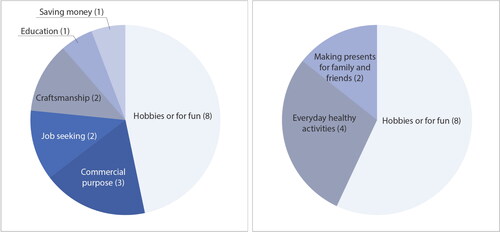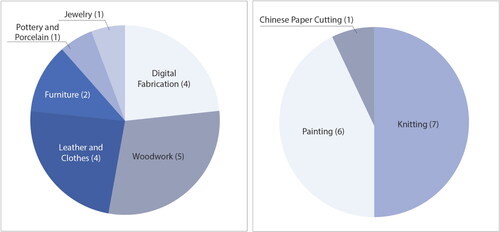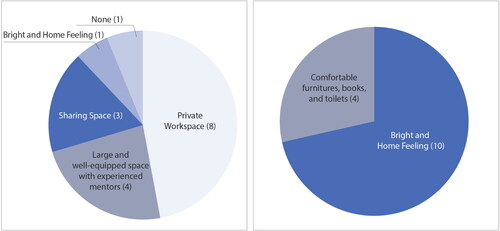Abstract
With the great benefits of ‘making’ including self-fulfilment and creativity development, the maker movement has become a social and global phenomenon with great demand for community-based makerspaces. This requires designing appropriate environments with well-developed creative activities in makerspaces to help improve the impacts economically and socially. Much research has investigated the topics of making/makerspaces but primarily focused on Western culture. This study, however, looks into the perceptions, experiences and requirements of people toward making/makerspaces, with an in-depth study of Chinese cases. A qualitative research methodology with mixed methods was employed. The study discusses the key stakeholders’ perspectives including their requirements and expectations, drivers for and barriers of current practices with possibilities of applying bottom-up approaches, and the potential of turning community centres into creative hubs. The key findings will be used to develop a prototype of public makerspaces in China.
Introduction
‘Creativity’ plays a crucial role in innovation, helping individual’s ways of living, business’s sustainable growth and societal improvement. Fostering creative citizens has, therefore, become a critical issue in most countries. Creative professionals can draw upon complex bodies of knowledge and apply creativity to solve complicated problems whilst people outside design/creative disciplines may find it challenging (Kotler and Rath Citation1997). ‘Creativity’ as a skill could be learned, developed, and applied (De Bono Citation2007), and engaging people in creative activities including co-design is considered an effective way of promoting and fostering creativity (Sanders and Stappers Citation2008). It is now commonly accepted that ‘making’ encourages participants involved in creative activities and co-design to work with those around them to solve problems while making (Dellot Citation2015), and makerspaces help intermediate and advanced makers to develop their skills and creativity (DCMS Citation2019). Thus, makerspaces, by providing spaces and tools for the public to engage in creative activities, e.g. modifying, and repurposing artefacts, can help foster and nurture creative citizens (Florida Citation2002). The spaces also make a significant impact on creating social value through societal engagement, creating self-fulfilment and positive behaviour changes (Dellot Citation2015).
The movement has enabled makerspaces to attract an increasingly broader audience in the past years, leading the dramatic growth in the number of makerspaces: about 900 makerspaces in the world (Make Citation2020) and approximately 440 FabLabs in 33 countries in 2015 (Smith Citation2015) – Makerspace is an umbrella term, which includes FabLabs and hackerspaces. There are many studies examining perceptions of and requirements for makerspaces to learn how best to create, design and utilize them for more benefits. However, the studies focused primarily on the issues raised in Western culture, and there is arguably limited research in the Eastern cultural context – despite high interest and demand for making and makerspaces in the Eastern countries (Saunders and Kingsley Citation2016). As the cultural differences often lead to critical incident misunderstanding (Kastanakis and Benjamin Citation2014), this could significantly impact on most research outcomes. It is, therefore, timely to investigate people’s perceptions and requirements for and experience of making/makerspaces and current practices in Eastern culture. In this study, Community Neighbourhood Centres in Shanghai have been selected as case studies because they have (i) been developing well in recent years playing multi-faceted roles in local people’s daily life, (ii) already hosted a variety of activities including making activities, thus can effectively attract a wide range of people from various demographic groups and (iii) great potential to turn into creative hubs for the general public.
The key research question arise from the above discussions is ‘How can community centres be explored as creative hubs to help Chinese citizens’ creativity enhancement through making?’. With the question, this paper discusses contextual issues, roles and means of making/makerspaces in China by (i) understanding key stakeholders’ perceptions of and requirements for public makerspaces and community creative hubs, (ii) identifying current approaches and practices of makerspaces and creative communities, (iii) investigating possibilities of applying a bottom-up approach, and (iv) exploring the potential to turn community centres into creative hubs. The results will be used as underpinning building blocks of a prototype of public makerspaces, applying to one of the community neighbourhood centres in Shanghai with the intention to scale up and expand to other areas in China, and finally of a strategic design framework for developing community creative hubs in China to foster creative citizens inclusively and deliver societal and economic impacts.
Research methodology
This research employed a qualitative research approach for a thorough understanding of current practices and in-depth discussions with stakeholders as the approach helps to determine underlying reasons, rationales, and opinions through investigating each issue, event, or phenomenon of interest in its context thoroughly (Crowe et al. Citation2011). A triangulation protocol with qualitative methods including case studies, interviews, observations, and field trip, was implemented to develop a comprehensive understanding of phenomena in the making sector and enhance the objectivity and reliability.
The first phase focused on the literature review with content analysis to understand how making and public makerspaces could be used strategically to foster creative citizens. The review included identifying the meaning, roles, and values of making/makerspaces; current approaches and practices in makerspaces and community centres; and differences between and benefits of top-down interventions and bottom-up approaches.
At the second stage, open-ended exploratory and in-depth interviews were undertaken with key stakeholders and users in a one-to-one format. The interviewees were two community leaders from Miyun and Fuxin Road community centres, two founders of makerspaces from Fablab O Shanghai and XinCheJian, one director from Fablab O Shanghai, one resident in XinCheJian, and 31 Shanghai citizens (17-younger aged between 20 and 50 and 14-older aged 50+; 13 male and 18 female; 10 makers and 21 non-makers) with diverse professions and education, such as school teachers, university students, IT technicians, designers, entrepreneurs, homemakers and retired people. The user samples were selected from various demographic segmentation as all could be the potential users of creative hub in the community. The interview covered three core issues: (i) the meaning of making; (ii) their experience and expectations; and (iii) potential roles of makerspace in their daily life. As the interviews were conducted in Mandarin Chinese, all the interviews were transcribed and translated into English, and thematic analysis was employed to extract key issues and cluster them into relevant themes.
A field trip was organized with 13 PGT design students from Tongji University, China. They were invited to visit two makerspaces, The Remakery and The Goodlife Centre, in London, aiming to understand Chinese perspectives on makerspaces and for them to gain insights from the current practices in the UK. They were observed during the visits and invited to an open discussion to share their experiences after the visits. All the observation notes and discussions were analysed with content and thematic analysis.
Lastly, five in-depth case studies were conducted at two makerspaces: XinCheJian and Fablab O Shanghai and three community centres: Miyun Road Community Neighbourhood Centre, Fuxin Road Community Neighbourhood Centre, and Citizen Service Station of Quyang Community Centre. Shanghai was selected since it has many community centres (社区睦邻中心) with strong potential to be developed into public makerspaces. Moreover, makerspaces in Shanghai are well established and have already hosted various activities, e.g. public talks. Therefore, both community centres and makerspaces could attract a wide range of people from different demographic groups, including those who might not have engaged with creative activities before. A literature review was conducted to learn current practices of both makerspaces and community centres, followed by interviews with managers and users, and observations focusing on the facilities, contents, activities, and targets. The study findings were analysed through PACT Analysis (People, Activities, Contexts and Technologies) as it supports human-centred design thinking and helps researchers understanding user interaction and experience (Benyon, Turner, and Turner Citation2005). By providing pre-defined categories, it helps ensure that the chosen experience was examined from multiple perspectives.
Making/makerspaces and creativity
Making helps individuals to create self-fulfilment in everyday life and develop creativity. Making can be described as a full expression of an individual’s creativity (Kuznetsov and Paulos Citation2010) and supports people therapeutically, e.g. stemming cognitive decline, controlling their emotions, and imbuing them with a deeper sense of meaning (Dellot Citation2015). Creative activities, such as making, contribute to improving their ability to create personal and contextually relevant technical artefacts (Tanenbaum et al. Citation2013), leading people to increase pleasure, unlock innovative capacity and build resilience in our society (Gauntlett Citation2018). Makerspaces, therefore, can be regarded as the heart of a platform for creativity through learning about ourselves and others.
With its origin in western culture, the concept of makerspace has grown into a global trend of sub-cultural development (Cheng Citation2019). Makerspaces can be defined as ‘an open workshop with different tools and equipment, where people can go independently to make something’ (Sleigh, Stewart, and Stokes Citation2015), informal sites for creative production where people explore ideas, learn technical skills, and develop new products (Sheridan et al. Citation2014), and spaces where individuals play creativity with a high level of self-organized activities with an open process (Sandvik and Thestrup Citation2017). These definitions illustrate the importance of makerspaces as being creative means providing opportunities to generate new ideas through new ways of thinking and problem solving, resulting in the betterment of innovation. The settings also help cultivate a collaborative culture, encourage close interactions between like-minded people and promote peer-learning and socialisation (Moilanen Citation2012). Most makerspaces currently offer formal classes that help members improve relevant skills, find employment, produce marketable goods, and developing entrepreneurship (Dellot Citation2015). Making for and by the public also contribute to the improvement of societal engagement and generate positive change in attitudes and behaviours toward social and environmental impact (ibid).
According to Dellot (Citation2015), makerspaces can be categorized into two ways: one is based on their autonomy (supporting from institutions or independent), and the other is their origin (demand-led or supply–led). Even with the distinction, makerspaces can also be grouped into FabLabs, Hackspaces, University-led, Single-discipline and independent, according to users, business models, governance, and tools (ibid). The term makerspace did not exist until 2005 and ‘became attached to community workshops where members share tools’ (Holm Citation2015). As the role of makerspaces has been expanded, DCMS (Citation2019) defines it as ‘physical locations where people gather to co-create, share resources and knowledge, work on projects, network and build’, where the public get an opportunity to make. Hackerspaces began as places where computer programmers and hackers shared skills in the mid-1990s in Germany (Fleming Citation2015) and were traditionally considered focusing on computers and electronics – oriented towards computers and the digital world – but no limit to the tools (Holm Citation2015). Most hackerspaces recently operate with a membership fee from those who are skilled and/or interest in the areas. FabLabs, on the other hand, originate from the Centre for Bits and Atoms at Massachusetts Institute of Technology that spread it as a model for digital fabrication workshops (Gershenfeld Citation2008). FabLabs can be described ‘as a network or an accumulation of high-tech workshops’, taking ‘making’ as an essential aspect (Walter-Herrmann Citation2013), and are equipped with various digital fabrication tools, CNC and milling machines, and cutters. FabLabs are generally open to the public but often have specific targets for educational/training purposes. Those discussions indicate that makerspaces are running for different purposes with different users, but they all create their own value, such as creativity enhancement, social engagement, and educational improvement.
Making/makerspace in China
People nowadays are willing to actively take part in creative activities if they are relevant and meaningful economically and socially. ‘Making’ in Chinese is Zhi-Zuo (制作), signifying traditional hand-making activities, e.g. woodwork and leatherwork and are related to two fundamental ideas of crafting and manufacturing. Chinese people often perceive making as a spiritual journey (escapism) enabling makers to escape from their reality, e.g. busy daily routines, and experience a nostalgic emotion through hand-making (Irie, Hsu, and Ching Citation2019). Due to the rise of economic development in recent years, big cities including Shanghai, Beijing, and Hangzhou, have witnessed a rapid emergence of leather and furniture-making stores that brand themselves as makerspaces. They sell materials and offer workshop spaces for people to handcraft products, e.g. wooden chairs (Fu Citation2016), and the membership fees in some makerspaces are high at 20,000 Yuan (approximately £2,200) per year (Zhang Citation2015).
Making as manufacturing in China is perceived as creative experiments in technology and digital fabrication in hackerspaces (Saunders and Kingsley Citation2016). In recent years, many hackerspaces/makerspaces have been established in big cities across China, such as Mushroom Cloud Maker SpaceFootnote1 in Shanghai and Chaihuo MakerFootnote2 in Shenzhen. One of the first hackerspaces in China, XinchejianFootnote3 was set up in Shanghai in 2010, because of China’s wider economic and political transformation (Lindtner and Li Citation2012). Thus, the terms ‘makers’ and ‘making’ in China started to be recognized as part of the mass innovation and entrepreneurship movement backed by the official policy. Subsequently, the number of makerspaces that combine the hacker culture with factories for start-ups has increased in the past few years. This type of makerspaces targets young people who need co-working spaces to share ideas, co-create with technologies on real issues and start their businesses. While sharing similar mass innovation goals, these makerspaces operate and function differently (Wang and Ye Citation2015), such as concentrating on making facilities, e.g. Chaihuo Maker, focusing on education, e.g. Tsinghua X-lab,Footnote4 and providing platforms for technology start-ups, e.g. 36 KrFootnote5 and co-working spaces, e.g. UrWork.Footnote6
Makerspaces and government-led top-down interventions
While the makerspace across the world is often initiated and driven by the grassroots smattering of collectives, the development of makerspaces in Asian regions is greatly facilitated in a top-down manner with high-level policy goals (Cheng Citation2019). In China, arguably, top-down interventions are inevitable because the making culture is associated with creative industry clusters, regarded as ‘a new type of urban revenue generator to stimulate urban growth and serve its own economic interests’ (Zheng Citation2010). The government has shown strong support to the development of makerspaces, as they are seen as an ‘upgrade’ from traditional manufacturing to digital fabrication and a transformation of the national economic model from ‘Made in China to Designed/Created in China’ (Saunders and Kingsley Citation2016).
Most makerspaces in China have been running in a business and education-oriented manner. They consider makerspace communities as ‘forward-looking (though rooted in existing practices of scrappy, resourceful shanzhai manufacturing), embodying a practice in which material creation is intrinsically bound up with a vision of China’s future as a hub of creativity as well as fabrication’. (Tanenbaum et al. Citation2013, 2607). Chinese makerspaces have been set up as incubators to support entrepreneurs with innovative experimentations or novel education providers for STEAM subjects (Xi, Wu, and Zhang Citation2017). According to our interviewees from makerspaces, making/makerspace are limited to the hacker-based entrepreneurship or education for the young generation; especially FabLabs’ primary focus is educating digital fabrication providing school students with opportunities to enhance STEAM education. In such a way, they can sustain themselves and obtain resources by responding to local policies (SCPRC Citation2015).
Shaji Village, also known as Taobao Village, can be seen as a good example of the top-down approach with its strategic framework for creative development. Shaji village was an agricultural area but has become a successful design and manufacturing hub for e-commerce products. The transformation began when a local creative entrepreneur set up a small company to manufacture and sell flat-pack furniture online. The success has led to a local e-commerce movement attracting investments and gained increased support from the government. Since 2014, the government has been working with the Alibaba Group to apply the Shaji Village model to help rural communities get better access to online goods/services and take their locally produced goods to the online market. In this model, creative entrepreneurs are supported and nurtured through infrastructure provided by the government, resulting in high growth of the villages (AliResearch Citation2011). Another example is SEG Makerspace in Shenzhen. SEG initially provided office spaces and 3D printing facilities targeting software start-ups (Xue Citation2018). The space was branded as a ‘makerspace’ and transformed into an ‘incubator and accelerator’ in response to the government call. The transformation was completed within 20 days of the government announcement supporting makerspace and received many visits from local politicians and investors (People.CN Citation2015). Those cases exemplify how top-down interventions can help scale up the making movement into successful businesses and indicate that the more commercial-oriented makerspaces have been developed bottom-up and receive government support to sustain and develop further. However, most cases appear to be homogenous as they serve with business purpose, and the voices from the grass-root communities are often absent.
The Chinese visitors to the UK makerspaces expressed that they were inspired by the grass-root forms and operation of makerspaces in the UK. Whilst the making culture in China and the UK is somehow similar in terms of the variety of makerspaces, FabLabs and hackerspaces and running with the purpose of economic, social and educational improvement (Sleigh, Stewart, and Stokes Citation2015; DCMS Citation2017; DCMS Citation2019), it was observed that most UK community-based makerspaces have been developed as public self-organisation, focusing on social value creation and running with full autonomy with its purpose. For example, The Remakery, combined with the features of a community centre (within and for the local people) and a hackerspace (providing space for enhancing creativity), helps societal engagements of residents and social entrepreneurship skill development. It seemed that, for the Chinese visitors, this kind of bottom-up approach would be hard to imagine in their counterparts in China.
There are ongoing debates about the desirability of top-down approaches. However, many situations require government interventions, including monetary policies, to achieve their environmental goals (Fuchs Citation2003). The effect of government interventions differs according to sectors, but the top-down approach is considered ‘productive’ especially in the public services and education sectors (Kneller, Bleaney, and Gemmell Citation1999). On the other hand, one of the noticeable benefits of a bottom-up approach is that people can feel more involved in the communication and decision-making, which leads them to be more self-motivated, creative, and interested in its future success (Park, Kim, and Krishna Citation2014). To create a more accessible and inclusive making culture in China, therefore, a bottom-up approach in conjunction with the top-down interventions should be considered.
Community centres as creative hubs with makerspaces
There are two makerspace models: (i) ‘community space’ – an exclusive makerspace serving a specific community of practice and (ii) ‘space for communities’ – an inclusive one providing space for multiple communities (Wang, Dunn, and Coulton Citation2015). The former model, e.g. libraries and community centres, helps introduce creative activities and run training sessions to the public. The latter focuses more on providing space and making facilities to help people socialize and build new relationships with like-minded people through making activities.
Most community centres in China have been established as a social space for wider residents. Currently, the centres are used mainly by older audiences, however, families with children and professionals still participate in selected programmes and events with various activities – see the case study summary in . In the context of the top-down interventions within the system in China, however, many grassroots making activities can still unfold within community spaces; the centres are overseen by local neighbourhood committees, who act as organizers of social activities for the public and as agents of authority (Tang Citation2013). The committees are responsible for managing urban healthcare and sanitation and for running educational and cultural programmes, with strong government support (Bray Citation2007). Most government support aims to enhance street-level governance by means of public self-organisation, helping policy implementation and promote the government’s legitimacy (Tang Citation2013).
Table 1. A comparison between makerspaces and community centres in Shanghai.
Local governments fund community centres in China, which are heavily influenced by governmental policies, i.e. the spaces are initially government initiatives, therefore limited opportunities for bottom-up development. Our interviews with community centre leaders mentioned that they offer great opportunities for many creative events and tend to be open to all sorts of activities, but only with permission from the centres’ management team. This cause potential issues that the provided activities/programmes do not always meet user requirements and often involve specific groups only. There are some advantages of top-down interventions, e.g. financial, and regulatory support; however, they should not disregard the opportunities to develop inclusive makerspaces in a bottom-up manner. Bottom-up approaches fundamentally try to communicate with a wide range of individuals and stakeholders for more inclusive decision-making. Our interview results indicate that many community centres have been gradually opening more opportunities for bottom-up and self-governance activities, aiming to create more impactful social value and form a sustainable business model in the long term. Therefore, it is timely that Chinese communities consider well-balanced top-down and bottom-up approaches for more inclusive and user-oriented community centres as creative hubs with makerspaces.
User experience and requirements in China
Making is traditionally considered as a way of practising hobbies or socialising for most Chinese people. Most interviewees stated that engagement with making is ‘optional’ since it is viewed as ‘an opportunity to practice hobbies and learn new things’ (). They are interested in making either artistic endeavours, e.g. painting, pottery and handicraft objects, or realisation of ideas with/without the technology. Our interview results illustrate there is no difference in perceptions and expectations toward making and makerspaces between makers and non-makers but significant distinctions between younger and older audiences due to the different aims. Therefore, it is crucial to understand the gaps to create a more inclusive making environment in community centres.
The younger group perceives making as an ‘alternative’ lifestyle whilst the older group sees it as ‘part of their daily life’. Makerspaces, for the younger, are the place to support creative practices and run training programmes, helping develop new techniques/knowledge and build start-up digital fabrication businesses. For the older, makerspaces are the space for their artistic recreation and achieve adequate levels of accomplishment with a self-motivated and positive attitude.
The interview results presented that the younger group’s perspectives on makerspace are heavily influenced by market need (). Those with educational backgrounds in creative fields stressed that they would choose fabrication technology and hand-making for their career development. They prefer to produce more things rather than too much discussion and expect a well-equipped workshop with sophisticated machines and tools, such as a 3D printer, laser cutter and CNC. Therefore, Xinchejian and Fablab O (established with an educational purpose) and Chaihuo (designed for a commercial purpose) would be good makerspaces as they are highly technology-orientated with a pragmatic approach. It was also noted that socialising in makerspaces is the least pressing consideration of this group.
For the older group, ‘making’ should be easy, practical, and relevant to their daily routines. Their primary making activities are recreational handcrafting works, e.g. knitting, painting and paper crafting, which are considered effective means of improving the physical and mental wellbeing (). They hope their artefacts is enjoyed by friends and families. An older interviewee stressed, ‘My making should be simple but practical. I made a fridge magnet in the community centre last time. It was useful and easy to learn’.
The respondents’ requirements for makerspaces also differ. While the younger group focus primarily on the work environment and resources, the older group consider the emotional aspects and essential functions within the space more (). The older pictured their ideal makerspace as a community centre that they are already familiar with and use frequently. They expected a comfortable and welcoming environment, with some functions related to their daily requirements, e.g. newspapers, books, and accessible toilets ().
The user interview presents some fundamental differences in expectations and requirements for makerspaces between younger and older groups, as their definition and purpose for using makerspaces are different. However, most interviewees suggested that it would be possible to design community centres as creative hubs with makerspace in which the younger can practice creative making activities with an educational purpose, and the older people can get involved in handcraft activities for the benefit of their mental well-being and socialisation.
Case studies of makerspaces and community centres in China
The aim of the case studies was to identify current making provisions at those spaces and exploring possibilities of transforming community centres into creative hubs using as public makerspaces for a wider public. The key findings are summarized under the themes of People, Activity, Context and Technology (PACT) and then compared between makerspaces and community centres (see and ).
Figure 4. People in makerspaces (XinCheJian, top left and FabLab O, top right) and community centres (bottom).
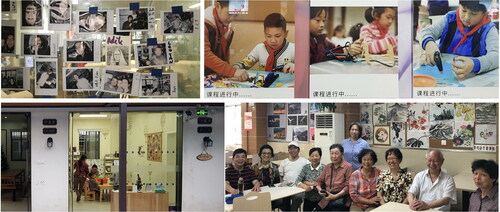
Figure 5. Activities in makerspaces (XinCheJian, top left and FabLab O, top right) and community centres (bottom).
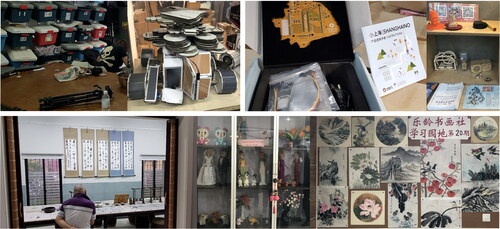
Figure 6. Context in makerspaces (XinCheJian, top left and FabLab O, top right) and community centres (bottom).
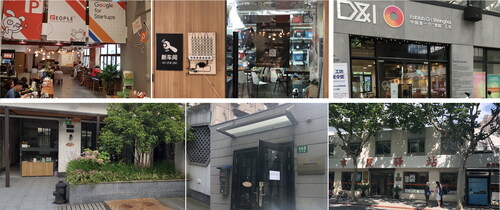
Figure 7. Technologies in makerspaces (XinCheJian, top left and FabLab O, top right) and community centres (bottom).
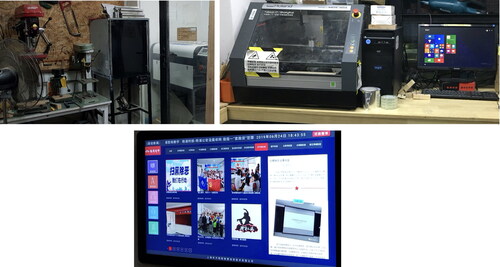
People
As the aims of makerspaces and community centres are dissimilar in China, their targets are also different. The two makerspaces accommodate a good number of makers but with different goals and target groups. As a club for amateur tech lovers, Xinchejian appeals to those who need a platform to prototype and promote their projects to digital artists, fashion designers and makers with a non-tech background. In contrast, Fablab O, focusing on education and training, receives secondary school students. The participants expect to have STEAM education to help them access better schools in the future.
All three community centres welcome all types of people with various facilities and activities; however, the primary users currently are older residents, who need a place for recreation and/or holding their interest group activities. Some centres, including Fuxin Community Centre, have succeeded in attracting wider groups by broadening their offer, e.g. multipurpose rooms, entertainment events, caring for children, and evening sessions – especially for professionals and families with young children. All the centres have many multipurpose rooms that can be utilized for skill training for young people. This suggests that the community centres can be run more inclusively with different groups, as is the centres' initial purpose. The participants in this study were from both Community of Practice (CoP) and Interest (CoI). The users of makerspaces, such as Xinchejian, all share passion in making and entrepreneurship and regularly interact to advance their skills further, and those who attended sessions at community centres and/or formed self-organized groups also share these common traits. The CoI group expressed their perspectives and expectations, which are very similar to the CoP; however, creative workshops could be organized to better understand them in the next stage of the study.
Activity
The core activities in the makerspaces are hacker related. Xinchejian claims to be the first hackerspace in China, providing space to support individuals in business development, especially for early start-up hacker businesses. They organize various workshops, enabling many start-ups to meet, share ideas and learn making skills from each other, using as a platform to launch their careers. Fablab O is the first certified global FabLab in China, aiming at building an ecological chain of entrepreneurship for Chinese makers, with its specific focus on developing STEAM laboratory and scientific innovation education. The founder stressed that many education programmes have been running in collaboration with local schools, including more than 100 open nights for interdisciplinary learning, 80 projects on software and hardware, teacher training and study tours, over the past few years.
Activities in the community centres are basically around public services with the facilities provided within the centres, e.g. self-service health check, making, exhibiting, sporting, and meeting. There are, however, some drop-in creative events self-organized by residents. Many older people organize and/or participate in craft sessions in Miyun Community Centre and painting and photography sessions in Quyang Community. Some programmes are linked to artistic work with daily practice, e.g. teaching people how to create upcycling artwork from reclaimed materials/waste.
Context
Both makerspaces have no direct link to the local communities. XinCheJian is in a small unit within a large co-working space in the city centre, opening 24/7 for members but less welcoming to others. It has limited space is filled with professional tools and storage containers. Fablab O is based in the College of Design and Innovation of Tongji University and is not interested in uptake from the wider community. It positions itself as distinct from the university, aiming at educating students. The lab has spread its network and set up many branches in other cities, including Shenzhen, Suzhou, and Weifang. On the contrary, the community centres are in the residential areas serving as a place to socialize and practice hobbies. The Quyang Community, for example, runs a community cafeteria offering inexpensive lunch menus, which welcomes everyone from working professionals to residents. Most centres provide meeting areas with newspapers and magazines that people easily and comfortably access.
Technology
The makerspaces have both digital and traditional workshop tools. They have equipped with professional tools including laser cutters and CNCs for training digital fabrication, 3D designs and manufacturing. They often communicate with people through social media, primarily using WeChat – the most popular social media app in China. By contrast, none of the community centres offers any professional making tools as the makerspace; however, they try to reach out to wider audiences through a digital platform to announce upcoming events, provide information and post pictures of events whilst people share images and comments. The platform is linked to WeChat. Both makerspaces and community centres do not use digital platforms to facilitate the making but emphasize hands-on making activities and social benefits through informal interactions in physical spaces, e.g. peer learning.
Discussions
This research revealed a great maker movement in China and making/makerspaces contribute to Chinese people, business, and society significantly, and Chinese people have distinct perspectives on making/makerspace between different age groups in terms of perceptions, preferences, and requirements. The difference has led to two strands of their making movement: (i) hacker-based exploration for young generations in makerspaces and FabLabs and (ii) hands-on recreation for citizens in community centres. Both cases show empowerment in creativity at a grassroots level; however, great differences in the goals, targets, activities, and technology use. The current operation models in makerspaces have well met the young makers’ needs for entrepreneurship skill development in the digital fabrication field and STEAM education, responding to the government’s policy goals and market demands. On the other hand, community centres in China act satisfactorily as social spaces for residents to engage with various activities, including handcrafting and making. Therefore, considering specific goals of makerspaces (FabLab/hackerspace) and community centres, it would be sensible to suggest that the makerspaces stay running in a professional/commercial oriented manner but with a more welcoming environment to non-members to enhance the public’s awareness and encourage them to get involved in making. However, it can be recommended that the community centres keep generating social values but should learn from the commercially operating makerspaces in terms of creativity enhancement and co-design skills development by running seminars and hands-on training programmes.
This study identified that community centres have strong potential to become creative community hubs for the public's creative activities. The drivers for this are (i) most centres are well-equipped and strategically located in the middle of residential areas, (ii) the multipurpose spaces in most centres can easily be adapted for creative making activities, and (ii) many centres already have substantial experience of organising and supporting creative making activities. However, with the different perceived needs and values from different age groups, bringing a wider range of citizens to community-based makerspaces together, could be a big challenge. Although the primary motivations for making between different age groups are somewhat similar, their preferences and requirements are very distinctive. Therefore, it could be considered that the community centres develop multi-purpose programmes/activities to fulfil all age groups’ needs: education for the younger and mental well-being and socialising for older. However, the multi-purpose approaches should also be flexible to meet each group’s requirements. In this case, co-design with all age groups in designing the programmes/activities would be beneficial. This issue can be directly related to the current top-down approach in China.
The current government interventions can be a challenge to developing the centres more inclusively. In exchange for government financial support, the centres are required to primarily meet policy goals; therefore, there are few opportunities for citizens to engage in designing creative activities. Bottom-up creative activities have occurred in different places at different levels, from the professional skills development in makerspace to the daily invention. Many community centres have started considering operating in a self-consistent way for more user-centred value creation – some selective programmes/events run by self-organized clubs or local groups illustrate a good rise of bottom-up initiatives cultivated in many community centres. However, for Chinese people, taking creative activities may not be an integral part of their daily life if they do not see economic value creation in the short-term or are too busy with work and social lives. Therefore, a more strategic approach to promote creative empowerment would be to engage the wider public in designing programmes and activities. Therefore, while top-down interventions remain prominent in the maker movement and the development of makerspaces in China, more opportunities for these kinds of bottom-up initiatives should be found to (i) engage with and benefit a broader range of people and (ii) better foster creative citizens and help improve their quality of life, in an inclusive manner.
Conclusion
This paper discussed the potential opportunities of turning community centres into creative hubs in China. The research identified that firstly, there are huge demands for making/makerspaces to enhance economic and societal impacts at the individual and governmental levels. Secondly, although makerspaces and community centres have been established and run with different aims, contexts, and targets, they have considered creativity empowerment on a grassroots level. Thirdly, current community centres have great potential to become creative hubs with the emerging demands for creative activities within local communities. Lastly, a bottom-up approach in conjunction with the current top-down interventions can be considered to support developing a more accessible and inclusive making culture in China. The research results will be used to develop a prototype of public makerspaces in the community neighbourhood centres. The knowledge created in this study will help understand of meanings, roles and goals of making/makerspace and user requirements in China. This study would benefit from further studies of (i) utilising the existing community centres for the wider key stakeholders, (ii) bringing different age groups in community-based makerspaces and (iii) maximising benefits of merging top-down and bottom-up approaches.
Disclosure statement
No potential conflict of interest was reported by the author(s).
Additional information
Funding
Notes on contributors
Y. Choi
Dr Youngok Choi is a senior lecturer and MA Design programme director at Brunel University London. Her research interests covers design policy and strategy, social innovation and user experience.
B. Lam
Dr Busayawan Lam is a Reader and the Director of Teaching and Learning at Brunel University London. Her current research interests include co-design, community-led design, and makerspaces.
X. Chen
Dr Xi Chen is a postdoctoral research assistant at Brunel University London. He is keen on exploring the role of an architect/designer who builds networks for collaboration across the professions, government, academia and the public.
S. de Sousa
Sophia de Sousa is Chief Executive in The Glass-House Community Led Design. She is an impassioned champion of design quality and enabler of design practices that empower people and organisations and that help communities thrive.
L. Liu
Dr Long Liu is a Professor at Tongji University, Shanghai, China. His major projects include safety management, risk management, information design and optimization, and usability study.
M. Ni
Dr Minquing Ni is an associate professor at Tongji University. She focuses on the research and practice link with community building and social innovation and explores how the socially engaged placemaking strategies could modelling a resilient community.
Notes
1 Mushroom Cloud Maker Space: www.mushroomcloud.cc
2 Chaihuo Maker: www.chaihuo.org
3 XinCheJian: www.xinchejian.com
4 Tsinghua X-lab: www.x-lab.tsinghua.edu.cn/en/
5 36 Kr: www.36kr.com
6 UrWork: www.ucommune.com
References
- AliResearch. 2011. “Investigation Report on ‘Shaji Village Model’.” AliResearch. Accessed October 16, 2020. http://www.aliresearch.com/Blog/Article/detail/id/12860.html
- Benyon, D., P. Turner, and S. Turner. 2005. Designing Interactive Systems: People, Activities, Contexts, Technologies. Boston: Addison-Wesley.
- Bray, D. 2007. “Building ‘Community’: New Strategies of Governance in Urban China.” Economy and Society 35 (4): 530–549. doi:10.1080/03085140600960799.
- Cheng, Y. 2019. “The Hybrid Gathering of Maker Communities in Taipei Makerspaces: An Alternative Worlding Practice.” City, Culture and Society 2019 (19): 1–16.
- Crowe, S., K. Cresswell, A. Robertson, G. Huby, A. Avery, and A. Sheikh. 2011. “The Case Study Approach.” BMC Medical Research Methodology 11: 100. doi:10.1186/1471-2288-11-100.
- DCMS. 2017. “Policy Paper 2. Digital Skills and Inclusion – Giving Everyone Access to the Digital Skills They Need.” Department for Digital, Culture, Media, and Sport. https://www.gov.uk/government/publications/uk-digital-strategy/2-digital-skills-and-inclusion-giving-everyone-access-to-the-digital-skills-they-need
- DCMS. 2019. “Guidance: Libraries and Makerspaces.” Department for Digital, Culture, Media, and Sport. https://www.gov.uk/government/publications/libraries-and-makerspaces/libraries-and-makerspaces
- De Bono, E. 2007. How to Have Creative Ideas: 62 Exercises to Develop the Mind. London: Vermilion.
- Dellot, B. 2015. Ours to Master: How Makerspaces Can Help us Master Technology for a More Human End. London: RSA Action and Research Centre.
- Fleming, L. 2015. World of Making. California: Corwin.
- Florida, R. 2002. “The Rise of the Creative Class: Why Cities with Gays and Rock Bands Are Losing out the Economic Development Race.” The Washington Monthly, May 2002, 15–25.
- Fu, C. 2016. “This Wood Workshop Outside Beijing Enable You to Be a Craftsman Away from the Hustle and Bustle (这家北京五环外的木工坊, 让你做个远离喧嚣的匠人).” https://www.jiemian.com/article/793782.html?_t=t
- Fuchs, D. A. 2003. An Institutional Basis for Environmental Stewardship: The Structure and Quality of Property Rights. Dordrecht: London Kluwer Academic Publishers.
- Gauntlett, D. 2018. Making Is Connecting: The Social Power of Creativity, from Craft and Knitting to Digital Everything. 2nd ed. Cambridge: Polity Press.
- Gershenfeld, N. 2008. Fab: The Coming Revolution on Your Desktop-from Personal Computers to Personal Fabrication. New York: Basic Books.
- Holm, E. 2015. “What Are Makerspaces, Hackerspaces, and Fab Labs?” SSRN Electronic Journal. doi:10.2139/ssrn.2548211.
- Irie, R. N., Y. Hsu, and Y. Ching. 2019. “Makerspaces in Diverse Places: A Comparative Analysis of Distinctive National Discourses Surrounding the Maker Movement and Education in Four Countries.” TechTrends 63 (4): 397–407. doi:10.1007/s11528-018-0355-9.
- Kastanakis, M., and V. G. Benjamin. 2014. “The Effect of Culture on Perception and Cognition: A Conceptual Framework.” Journal of Business Research 67 (4): 425–433. doi:10.1016/j.jbusres.2013.03.028.
- Kneller, R., M. Bleaney, and N. Gemmell. 1999. “Fiscal Policy and Growth: Evidence from OECD Countries.” Journal of Public Economics 74 (2): 171–190. doi:10.1016/S0047-2727(99)00022-5.
- Kotler, P., and G. A. Rath. 1997. “Design: A Powerful but Neglect Tool.” In Marketing and Design Management, edited by M. Bruce and R. Cooper, 16–21. London: International Thomson Business Press.
- Kuznetsov, S., and E. Paulos. 2010. “Rise of the Expert Amateur: DIY Projects, Communities, and Cultures.” In Proceedings of NordiCHI'10, Reykjavik, Iceland, 295–304.
- Lindtner, S., and D. Li. 2012. “Created in China: The Makings of China’s Hackerspace Community.” Interactions 19 (6): 18–22. doi:10.1145/2377783.2377789.
- Make. 2020. “Makerspace Directory.” Accessed December 1, 2020. https://makerspaces.make.co
- Moilanen, J. 2012. “Emerging Hackerspaces – Peer-Production Generation.” Proceedings of 8th International Conference on Open-Source Systems, Hammamet, Tunisia, 94–111.
- Park, S., J. Kim, and A. Krishna. 2014. “Bottom-Up Building of an Innovative Organization: Motivating Employee Intrapreneurship and Scouting and Their Strategic Value.” Management Communication Quarterly 28 (4): 531–560. doi:10.1177/0893318914541667.
- People.CN. 2015. “Segmaker Space – Make a Warm Platform for Makers (赛格创客中心—做一个有温度的创客平台).” People.CN, December 2015. http://it.people.com.cn/n1/2015/1229/c203889-27992349.html
- Sanders, E., and P. Stappers. 2008. “Co-Creation and the New Landscapes of Design.” CoDesign 4 (1): 5–18. doi:10.1080/15710880701875068.
- Sandvik, K., and K. Thestrup. 2017. “Challenging Makerspaces.” Proceeding of NordMedia 2017. https://curis.ku.dk/ws/files/186091046/thestrup_sandvik_paper_nordmedia2017_final_version.pdf
- Saunders, T., and J. Kingsley. 2016. Made in China: Makerspaces and the Search for Mass Innovation. London: NESTA.
- SCPRC. 2015. “Four Policies to Support the Space for ‘Mass Innovation’ to Help Entrepreneurs Realize Their Dreams (四项政策支撑“众创空间” 助创业者实现梦想).” The State Council of The People's Republic of China, January 2015. http://www.gov.cn/zhengce/2015-01/29/content_2811655.htm
- Sheridan, K., E. R. Halverson, B. Litts, L. Brahms, L. Jacobs-Priebe, and T. Owens. 2014. “Learning in the Making: A Comparative Case Study of Three Makerspaces.” Harvard Educational Review 84 (4): 505–531. doi:10.17763/haer.84.4.brr34733723j648u.
- Sleigh, A., H. Stewart, and K. Stokes. 2015. Open Dataset of UK Makerspaces: A User’s Guide. London: NESTA.
- Smith, A. 2015. “Tooling Up: Civic Visions, FabLabs, and Grassroots Activism.” The Guardian, April 2015. https://www.theguardian.com/science/political-science/2015/apr/04/tooling-up-civic-visions-fablabs-and-grassroots-activism
- Tanenbaum, J., A. Williams, A. Desjardins, and K. Tanenbaum. 2013. “Democratizing Technology: Pleasure, Utility and Expressiveness in DIY and Maker Practice, Paris, France.” Proceedings of CHI'13, 2603–2612.
- Tang, W. 2013. “Authoritative and Efficient Governance within Urban Communities – A Case Study Based on T Community (城市社区中的权威效能治理 – 基于T社区的个案研究).” Zhejiang Social Science 2013 (4): 86–94.
- Walter-Herrmann, J. 2013. “FabLabs – A Global Social Movement.” In FabLab of Machines, Makers, and Inventors, edited by J. Walter-Herrmann, 33–46. Hannover: VW-Foundation.
- Wang, D., N. Dunn, and P. Coulton. 2015. “Grassroots Maker Spaces: A Recipe for Innovation?.” Proceeding of 11th European Academy of Design Conference. Paris, France: Paris Descartes University Institute of Psychology.
- Wang, Y., and A. Ye. 2015. “From Makerspace to Mass Innovation Space: Analysing the Functional Model and Service Path Based on Innovation 2.0 (从创客空间到众创空间: 基于创新 2.0 的功能模型与服务路径).” e-Education Research 2015 (11): 5–12.
- Xi, Q., W. Wu, and Y. Zhang. 2017. “Makerspace Activities in China.” Science & Technology Libraries 36 (4): 425–433. doi:10.1080/0194262X.2017.1392920.
- Xue, Y. 2018. “Made in China: The Boom and Bust of Makerspaces.” SIXTH TONE. https://www.sixthtone.com/news/1003171/made-in-china-the-boom-and-bust-of-makerspaces
- Zhang, W. 2015. “The Coolest Thing Today Is to Go to the Wood Workshop and Make Your Own Chair (现在, 最酷的事是到木工坊里做一把自己的椅子).” Qdaily. https://www.qdaily.com/articles/12868.html
- Zheng, J. 2010. “The “Entrepreneurial State” in “Creative Industry Cluster” Development in Shanghai.” Journal of Urban Affairs 32 (2): 143–170. doi:10.1111/j.1467-9906.2010.00498.x.

